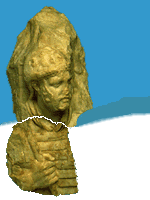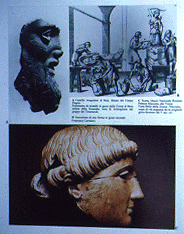

Copying through Molds and Casts
We are accustomed to thinking of casts in the context of the mass production of crafts or utilitarian objects, from lamps to fine china with relief decoration.  In
actuality, the cast obtained through direct impression can be an essential
step in the creation of a work of art, especially in the case of sculpture.
The imitation and adaptation of classical Greek sculptures that characterized
much of the output of Roman sculptors in the first centuries BC/AD were
predicated upon a continuous copyist tradition. Because the most famous
statues were not always available in the places where Roman sculptural
workshops operated, three-dimensional casts produced from molds fabricated
directly from esteemed works of art were indispensable.
In
actuality, the cast obtained through direct impression can be an essential
step in the creation of a work of art, especially in the case of sculpture.
The imitation and adaptation of classical Greek sculptures that characterized
much of the output of Roman sculptors in the first centuries BC/AD were
predicated upon a continuous copyist tradition. Because the most famous
statues were not always available in the places where Roman sculptural
workshops operated, three-dimensional casts produced from molds fabricated
directly from esteemed works of art were indispensable.
A series of ancient plaster fragments discovered at Baiae in 1954 made an important new contribution to our knowledge of ancient copying techniques, which was previously based primarily on literary sources. It has recently been demonstrated that the Baiae fragments represent plaster casts of famous bronze sculptures, probably used as three-dimensional models in a local workshop of copyists.
Still more recently (1981-82), fragmentary terracotta cult statues of the Augustan period were uncovered in excavations near the Palace of Tiberius on the Palatine Hill in Rome. These terracotta sculptures were fashioned from molds of bronze Greek originals that date to the fifth and fourth centuries BC.
Copyright ©1997, 2002 Ministero per i Beni Culturali e Ambientali, Soprintendenza Archeologica di Roma and the Kelsey Museum of Archaeology, University of Michigan. All rights reserved.
 |
 |
 |
 |
 |
 |
 |
 |
 |
 |
 |
 |